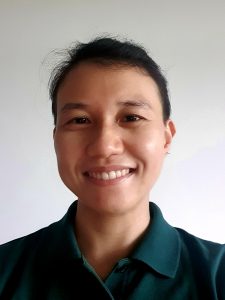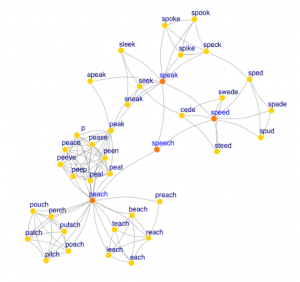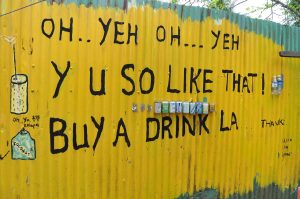CYNTHIA SIEW
 Assistant Professor Cynthia Siew (NUS Department of Psychology) was recently granted the FASS Award for Promising Researcher (APR). This award is presented to researchers who have produced research that shows potential impact and promise. Dr Siew received her MA and PhD in Cognitive Psychology from the University of Kansas, Lawrence, and her B. Soc. Sci. in Psychology from NUS. Her primary research interests are in lexical retrieval, development of the mental lexicon, and network analysis. Dr Siew's major current research grants are 'The Small World of Singlish Words: Mapping the Associative Structure of the Singaporean Mental Lexicon', awarded by DSO National Laboratories, Singapore; 'Global trends of language endangerment', awarded by the Ministry of Education, Singapore; and 'The influence of phonological, orthographic, and semantic similarity structure of memory on language processing and cognition', awarded by the National University of Singapore. She has published in Journal of Experimental Psychology: General, Cognitive Science, Proceedings of the Royal Society A: Mathematical, Physical and Engineering Sciences, and Complexity. A psycholinguist, Dr Siew is especially interested in investigating how people are able to 'find' the words they need in any given instant from our vast and complex mental libraries.
Assistant Professor Cynthia Siew (NUS Department of Psychology) was recently granted the FASS Award for Promising Researcher (APR). This award is presented to researchers who have produced research that shows potential impact and promise. Dr Siew received her MA and PhD in Cognitive Psychology from the University of Kansas, Lawrence, and her B. Soc. Sci. in Psychology from NUS. Her primary research interests are in lexical retrieval, development of the mental lexicon, and network analysis. Dr Siew's major current research grants are 'The Small World of Singlish Words: Mapping the Associative Structure of the Singaporean Mental Lexicon', awarded by DSO National Laboratories, Singapore; 'Global trends of language endangerment', awarded by the Ministry of Education, Singapore; and 'The influence of phonological, orthographic, and semantic similarity structure of memory on language processing and cognition', awarded by the National University of Singapore. She has published in Journal of Experimental Psychology: General, Cognitive Science, Proceedings of the Royal Society A: Mathematical, Physical and Engineering Sciences, and Complexity. A psycholinguist, Dr Siew is especially interested in investigating how people are able to 'find' the words they need in any given instant from our vast and complex mental libraries.
We congratulated Dr Siew and spoke to her about her research work.
1. How did you come up with the idea for your start-up grant, ‘The influence of phonological, orthographic, and semantic similarity structure of memory on language processing and cognition’?

Actually, it is not so much of a specific idea, but a natural extension of my research program, which has always been focused on figuring out what the structure of the mental lexicon is like and how that structure affects the way we understand and use language. One can think of the lexicon as a mental dictionary that stores the form and meanings of the tens of thousands of words you know, but all of that information is clearly not organized as if it were a physical dictionary (or thesaurus). Many people have different ideas about how this dictionary of words is organized, but I think a good starting point is to acknowledge that words can be related to other words in many ways—for example, based on sharing the same sounds or letters, or similar meanings, and so it is useful to draw on a framework like network science to model these relationships. The start-up grant has helped fund the psychological experiments and computational modelling that I conduct to understand our mental “dictionaries”.
2. What initially drew you to the study of psycholinguistics?
I was first exposed to psycholinguistic research way back when I was an undergraduate at NUS. In my honours thesis research I conducted experiments to examine how lexical properties of words and the quality of the auditory stimulus affected spoken word recognition. I think I would not have been a language researcher if not for this very formative experience—I hope that my then-HT supervisors-now-colleagues realize how important this experience was for sowing the seeds of my research career!
3. How did you develop an interest in Network Science?

To provide a bit of context for the reader, Network Science is an interdisciplinary field that studies complex systems (like the internet, social systems, transportation networks) as networks. More information about Network Science can be found here. A network consists of nodes and links. The networks I study consist of words that are connected in various ways. In the figure below you can see a network of English words that are connected if they sound similar. For instance, the words “speech” and “peach” are connected.
A confluence of things happened at the same time. At that time I was applying to graduate school and researching for potential PhD supervisors, and found that one of them (Mike Vitevitch at the University of Kansas) had published a couple of papers using network science to model the phonological lexicon. This piqued my interest and I started reading all the books I could find on networks. Then there was a Complexity Science conference that took place at NTU where I was working at that time. Many of the big names in complex systems and network science were in attendance and I learned about the potential of networks for understanding the structure of diverse complex systems from the internet to the human brain. Since words are, of course, related to other words, which are related to other words, and so on, I really wanted to study language networks and decided to do my PhD with Mike, and here I am.
4. Could you describe the project you are currently working on, ‘The Small World of Singlish Words: Mapping the Associative Structure of the Singaporean Mental Lexicon’?

The goal of this project is to collect word associations for uniquely Singlish words like “kiasu”, “lepak” and “bojio”, through Singaporeans playing a word association game online. It is a really easy and intuitive game – all you have to do is to answer this question: What is the first word that comes to your mind when you read the word “bojio”? The research team recently finished the web application, which you can access here. Your playing the word association game will help us discover the semantic relations between uniquely Singaporean concepts and build the first associative model of the Singaporean mental lexicon. So please stay tuned!
5. Which research publication are you most proud of and why?

The publication that I am most proud of is the one about spreadr, which is an R package that I wrote that simulates spreading activation in a network (published in Behavior Research Methods). I’m really proud of this publication for two reasons. The first reason is more personal—I had the idea of creating such an R package close to the beginning of my PhD, but did not have the requisite skills as I was still learning how to program in R. It took about 5 years before the package was stable and the paper was finally published. I learned a lot about perseverance from this process. The second reason is that I believe this paper has the potential to be an influential one in the field. The goal of this paper was to encourage language and cognitive scientists to explicitly consider how the structure of cognitive systems affects the way people process information by providing them with a simple and flexible framework for conducting computer simulations. This is a theoretically important question in my field and so it is very gratifying to see some recent papers using spreadr to model various language-related processes. I am looking forward to seeing even more creative uses of spreadr!
6. Which researcher has been most influential for you?
My PhD supervisor Mike and my post-doc supervisor Thomas Hills from Warwick University. Perhaps an unsurprising answer, but I really mean it! Both have been excellent research mentors, and particularly influential in terms of shaping my research approach, teaching me not only how to answer questions in my field, but also what questions should be asked, the latter being quite hard to do well. More important are the more “human” aspects of a research career. From both Mike and Thomas I also have learned how to be a good citizen of academia, and how to be a good teacher, supervisor, and mentor to my students.
7. What has been your most memorable teaching experience at NUS?

I’m teaching “Networks in Psychology” (PL4246) this semester where students learn about network science and apply their newly gained network analysis skills to analyze a psychological network for their final project. I have been really amazed by the creativity, diversity, and sheer quality of the projects. My students analyzed word-occurrence networks of Reddit comments about Covid-19, social networks of their friends and residences, and psychometric networks of dark triad personality questionnaires—just to list a few examples. All are great examples demonstrating the flexibility and usefulness of the network science approach. It has been a highly gratifying and memorable teaching experience.
8. Lastly, what research avenues are you keen on pursuing in future?

I want to bring Singapore to the international stage of psycholinguistic research. Current research in many areas of psychology are, unfortunately, too Western-centric, and tend to overlook the diversity that exists in the world’s languages and cultures. I believe that the multilingualism of Singaporean society offers an important opportunity to ask how the semantic structure of the mental lexicon is influenced by the specific cultural and historical contexts that it is embedded in. For instance, words like “blur” and “mug” have an interpretation and meaning that is quite unique to Singaporeans, but not to other speakers of English, even though those words also exist in their lexicons! (Consider: “This photo is blurred by the fog” vs “You might need to explain the instructions again; he is very blur”.) The “Small World of Singlish Words” is a long-term project that aims to collect the data that will enable us to conduct such cross-dialectical comparisons, and to track how the meanings of words change over time and potentially differ across generations of Singapore English speakers. I am also keen to apply my network models to languages other than English, and to study how multilinguals represent words and concepts from the different languages in their mental lexicon.
Thank you very much for taking the time to answer these questions, Dr Siew! And congratulations again on being awarded Promising Researcher!

